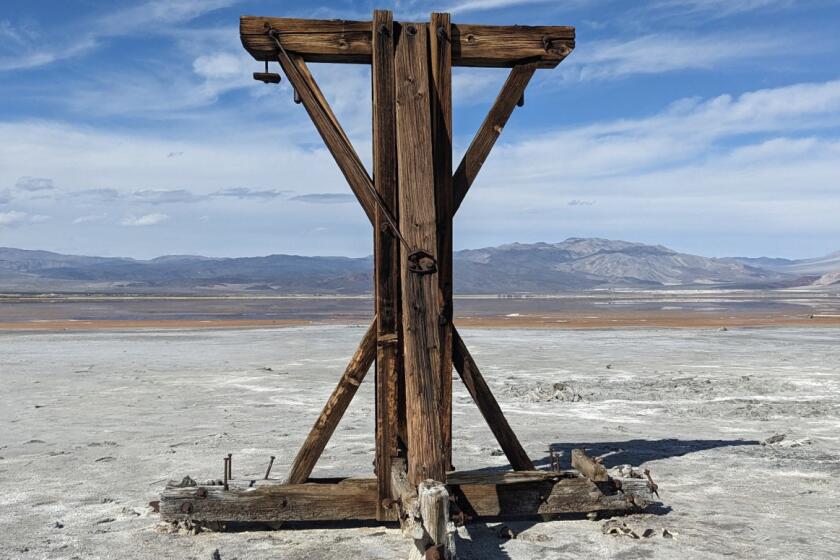Crunch Time
Drive up Hillmont Avenue, behind the Ventura County Medical Center, and there it is: Ventura’s outdated and overcrowded juvenile hall.
The plumbing system is so antiquated that the county has had to pay $5,000 apiece to have special toilets made to hook up with the ancient pipes.
There is no kitchen. Every meal is brought by truck from the county jail.
And the hall’s one-room infirmary--which serves up to 200 kids from three facilities--is small and cramped, with no windows.
Up to 140 kids are crammed into the hall built 30 years ago to hold 84.
The severe space crunch and the overflow at three other juvenile facilities recently prompted county supervisors to approve money for a $1.2-million conversion of an adult work-furlough building at Camarillo Airport into a 40-bed youth facility.
But the head of Ventura’s probation agency said the move will only be a Band-Aid on a system already strained to the breaking point.
Space remains so tight at juvenile hall that probation officers have to juggle everyone, sometimes locking the young people into their tiny 8-by-8-foot cells just to clean up after meals.
The long-term space problem has been exacerbated in recent years by the increasingly violent criminals coming into the system.
“The gang problems have really intensified,” said Daryl Dixon, who has worked at juvenile hall for the past 18 years. “We used to be able to congregate all the kids out in the yard at one time. Now, because of the gang problem, we can’t do that. Kids are a lot more violent. And attitudes are changing.”
The shortcomings of the overcrowded system are not lost on those who live in it. The more savvy among them know it works to their advantage.
“You get out earlier,” said 16-year-old Moses, who was incarcerated after being caught with a sawed-off shotgun while on probation.
“It’s better having a roommate,” said 16-year-old Jeff, who is serving time for robbery. “You can talk. It’s boring being in there alone.”
Chris Weidenheimer, who heads juvenile hall, said the two boys are typical.
“They know they’ve gotten breaks from the judges because there aren’t enough facilities,” Weidenheimer said. “They are kind of cagey about playing that game. They know no one wants to exacerbate the overcrowding problem. So they just push the limits a little further.”
In the meantime, the crowding only intensifies tensions among the headstrong teen population authorities say is more volatile than its adult counterpart.
The kids get 45 minutes a day outside--less than the hour required by the state--in a concrete-floored pen, with windows and walls on all four sides. They can’t see a flower or a tree, just the grass that grows between cracks in the crumbling concrete. Coiled barbed wire reaches to the sky.
The mostly male, mostly teenage population of young criminals is filled with pent-up adolescent energy, but there is no place to move.
Officials plan to install a 10-station parcourse in a tiny 30-by-30-foot concrete yard, Weidenheimer said. Then they can run the youths through like gerbils to tire them out, she said.
“Busy kids are better,” Weidenheimer says. “They are tired when they go to bed.”
Indeed, the facility is so woefully outdated that a 1997 inspection by the state Board of Corrections condemned the building for compromising the security of the facility and the safety of staff and minors. It basically recommended that the county tear the building down.
“In general we found your facility to be antiquated, and inadequate from a physical-plant standpoint and in need of replacement,” the report concluded.
Only one room in the facility is made for two beds. It was once an office, and the beds are affixed diagonally on the wall so that the room meets state standards that require the beds to be at least 3 feet apart.
When the population climbs to 112, 37 of the offenders are squeezed into unauthorized doubles, Weidenheimer says.
The facility was built before today’s standards were enacted, but the county is essentially blocked from doing any new construction because that would require the entire facility to meet new standards, Weidenheimer said.
The teenage inmates and frazzled staff experience the pressure in terms of shorter family visits, more fighting and more lock-down in the tiny cells.
Ultimately the community feels the pressure, too, with shorter sentences for young offenders and more violent offenders who should be locked up being released sooner to make way for others.
“Something is going to happen,” Weidenheimer predicted. “We would hate to see a kid escape and hurt someone, or hurt themselves. We are so anxious to get a new facility without a tragedy preceding it.”
The county is expected to release a study by the end of the month that recommends construction of a $55-million to $60-million juvenile justice facility.
It would include detention space, more than 300 new beds, courtrooms and various on-site counseling services.
More to Read
Start your day right
Sign up for Essential California for news, features and recommendations from the L.A. Times and beyond in your inbox six days a week.
You may occasionally receive promotional content from the Los Angeles Times.






